|
Local Road Research Board News
 NEW GUIDEBOOKS
Guidelines for Using Intelligent Warning Devices
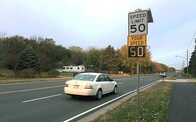
Local agencies receive requests for various intelligent warning devices. Since these technologies are relatively new, agencies are looking for guidance on their effectiveness and how to use them. This resource provides information on four intelligent warning devices including LED-enabled signs, radar speed feedback signs, rectangular rapid flashing beacons and dynamic “no turn on red” signs. It details their use, effectiveness, recommended installation protocols, alternative countermeasures to consider, and maintenance considerations. With this guide, agency staff can identify whether implementation of such devices is warranted and provide sourced responses to citizen’s requests for them.
|
Pavement Marking Decision Tree

This interactive tool is designed to assist cities and counties making decisions about which pavement marking material to use, whether it be for a new surface or when replacing existing markings with a different material. The online decision process tool guides agencies in narrowing their options. It includes summary data sheets on each pavement marking material, a "Did You Know Q&A," and links to additional resources.
|
Drainage 101: County Roadways, Streets and Drainage Ways Best Practices and Resource Guide
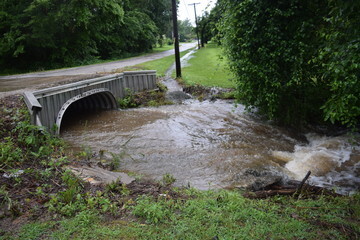
The process involved in researching drainage law and defining the best approach to solving drainage issues can be substantial and time consuming. This resource provides quick access to information cities and counties need to understand legal solutions to recurring drainage issues and solve their particular situation. The guide also contains information which might be useful to local elected officials, private property owners and other interested parties. It offers concise educational materials that simplify and inform about drainage issues and laws related to regional watershed protection, county road and highway ditches, city street storm sewers, and related drainage infrastructure.
|
NEW RESEARCH
Enhancing Pedestrian Experiences at Roundabouts

Traffic roundabouts are safer and more efficient than traditional intersections for vehicles and pedestrians. However, public unease about roundabout safety lingers. Concerns are related to confusion over appropriate vehicle–pedestrian sequences, visibility of the entire intersection and safety in general. In this study, researchers identified 15 roundabouts across the state with known pedestrian complaints. They analyzed the crossing safety features and configurations. After review of video footage from the pedestrian crossings at eight test sites, investigators identified the roundabout characteristics that correspond with the highest rates of drivers yielding to pedestrians. The resulting guidance contains roundabout design elements aimed at enhancing the pedestrian experience.
|
Criteria and Guidelines for Three-Lane Road Design and Operation
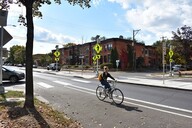
Reconfiguring roadways can be a low-cost safety solution that makes space for different travel modes in addition to motor vehicle traffic. Typically, a four-lane, undivided roadway is converted to a three-lane road with two directional motor vehicle lanes separated by one bidirectional turning lane. The extra space gained may be used for a bike, bus or parking lane or a shoulder; to widen sidewalks; to add safety features; or to add green infrastructure. However, losing two motor vehicle travel lanes could result in a more congested road or a decreased motor vehicle level of service during certain hours of the day. This research provides guidance that gives local engineers an initial indication of whether a road conversion would result in a loss of capacity given the roadway motor vehicle traffic demand.
|
Towards Implementation of Max-Pressure Signal Timing on Minnesota Roads
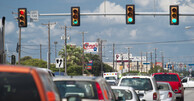
Long lines and delays at traffic lights are frustrating and costly for everyone. Max-pressure traffic signal control, a new signal timing method, shows promise as a method to make traffic signals more adaptive to real-time traffic. Max-pressure traffic signal controllers detect real-time vehicle queue length—vehicles entering and exiting the intersection—to optimize signal timing. This method uses a mathematically proven model to calculate a pressure value for each phase, activating the one with the greatest pressure. The algorithm dynamically adjusts phase sequence within seconds based on real-time traffic measurements. Hennepin County operates over 450 traffic signals, all of which are traffic actuated. This project investigated and resolved issues with max-pressure traffic control to prepare for a pilot study of intersections in Hennepin County.
|
PROJECT SHOWCASE
OPERA Project: The Otter Claw
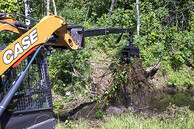
Otter Tail County Highway Department staff handle many water-related problems affecting county roads, including frequent stream backups caused by beaver dams and other obstructions. Culvert cleaning crews spend hours manually unclogging culverts, which can be dangerous and labor-intensive.
County highway maintenance workers Brody Bakken and Dennis Bosek designed a solution – the Otter Claw – that saves time and enhances safety. The skid steer attachment can extend up to 15 feet, allowing the operator to remove large amounts of debris in as little as 10 minutes from culverts, ditches and other hard-to-reach locations.
The original design of the Otter Claw, which taps into the hydraulic system of the skid steer, included a rotatable grapple claw fabricated from exhausted steel plow cutting edges. Its effectiveness was somewhat limited by a need to manually adjust the orientation of the claw repeatedly using a removable pin. With a $6,000 grant from the Local OPERA Program, the Otter Tail County Highway Department developed an omnidirectional hydraulic swivel head, which improved the strength, durability and ease of use.
The OPERA program is sponsored by the Minnesota Local Road Research Board and administered by Minnesota LTAP. Learn more about OPERA and the Otter Claw.
|
Snowplow Driver-Assist System Receives Research Partnership Award
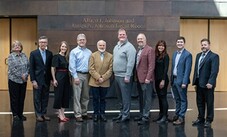
During harsh winter weather, snowplow drivers must work in the low-visibility conditions that keep other people off the road. These conditions can make it difficult to center the complex vehicles in the lane and avoid obstacles.
For nearly three decades, a research team has worked to develop driver-assist technologies and improve safety and performance. This extensive line of research received this year’s Robert C. Johns Research Partnership Award from the Center for Transportation Studies.
The system was developed and refined under multiple research projects funded by MnDOT along with other sponsors and partners, including the Minnesota Local Road Research Board.
Leveraging evolving GPS, radar, and related technologies, the system helps drivers with navigation and alerts them to potential hazards ahead. A display mounted to the dashboard has simple icons to show the truck’s lateral foot-by-foot position within the lane.
Photo: Members of the research team and Robert Johns (second from left) at the 2023 CTS Annual Meeting and Awards Luncheon. Photo credit: University of Minnesota.
|
ASSISTANCE
Introducing the MnDOT Digital Library
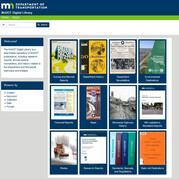
City and county practitioners now have a great new resource at their fingertips. The MnDOT Digital Library, recently launched by the MnDOT Library, is a public repository of publications produced by MnDOT, including documents originally created in a digital format and those that have been digitized. It features 12 collections that include research reports, State Aid publications, annual reports, photographs, state highway maps, photographs and historical publications dating back as far as 1917.
Each item in the digital library has a persistent link, which means that it won’t break, making access to this information reliable into the future. To date, there are more than 2,247 items in the digital library, with plans to make thousands more available.
|
WORKSHOPS & TRAINING
-
Are Your Ponds Serving Their Water Quality Function?, A presentation of LRRB research at City Engineers Association of Minnesota, June 1, noon, virtual
-
Minnesota Truck-Weight Education for Road Authority and Enforcement Staff, Minnesota LTAP, June 13, 9 a.m. to 3:30 p.m., St. Cloud
-
West Central Minnesota Toward Zero Deaths Regional Roundtable, June 14, 10 a.m. to 2 p.m., Fergus Falls
-
Roadway Construction Focus Four and Heat Hazards, Minnesota LTAP, June 15, 7:30 to 11:30 a.m., virtual
-
Minnesota County Engineers Association Summer Conference, June 21-23, Alexandria
-
TRB International Conference on Low Volume Roads, July 23-26, Cedar Rapids, IA
LRRB UPDATES
Welcome new RIC members!

We're excited to announce that Aaron Holmbeck, Darrick Anderson and Paul Oehme have joined the LRRB Research Implementation Committee. Aaron is the public works director and county engineer for Nobles County. Darrick is highway engineer for Cass County. Paul is the public works director for the City of Lakeville, he has served on the LRRB since 2015, and in this new role he also will serve as RIC liaison to the LRRB. Pictured (l-r): Aaron Holmbeck, Darrick Anderson and Paul Oehme.
|
2023 Minnesota Transportation Conference Recap
Minnesota Local Road Research Board • lrrb.org
|
|
|
LRRB invites and encourages participation by all people in their programs, services and activities.
- If you need an ASL, a foreign language interpreter, or documents in an alternative format (such as braille, large print or in a different language) at no cost, please email your request to Janet Miller at ADArequest.dot@state.mn.us or call 651-366-4720. Relay service: 711.
- If you need any another reasonable accommodation to participate (such as seating modification or auxiliary aids), please email your request to Accessibility.DOT@state.mn.us or call 1-833-400-8432. Relay service: 711.
|
|
|
|
|